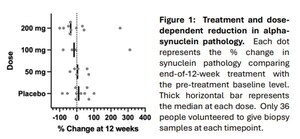
Launched in 2019, the Syn-One Test is used by neurologists and other clinicians in all 50 states to aid in the diagnosis of synucleinopathies
SCOTTSDALE, Ariz., Nov. 6, 2025 /PRNewswire/ -- CND Life Sciences (CND), a medical technology company pioneering the development of cutaneous neurodiagnostic tests and associated biomarker services, today announced a major milestone for its mission – the completion of the 50,000th skin biopsy-based Syn-One Test. The Syn-One Test is a laboratory developed test (LDT) designed to aid clinicians in the diagnosis of synucleinopathies like Parkinson's disease (PD), dementia with Lewy bodies (DLB), and other related disorders. More than 3,000 neurologists and other clinicians across all 50 states have used the Syn-One Test, which involves a routine office-based skin biopsy procedure.
"Neurologists and other clinicians continue to express their earnest appreciation for the Syn-One Test, as it provides valuable information to help diagnose synucleinopathies, which are complex neurological conditions that are often difficult to accurately identify," said Richard Morello, CEO of CND. "I would like to thank CND's co-founders and all team members, who have worked diligently to achieve this milestone. We remain focused on our mission to advance the care of patients who face the potential diagnosis of a neurodegenerative disease."
The Syn-One Test is the only commercially available solution of its kind, applying proprietary techniques to detect and visualize phosphorylated alpha-synuclein (P-SYN) in cutaneous nerves. It uses three small skin biopsy samples collected from three specific anatomical locations on each patient to identify the abnormal P-SYN protein, while also measuring peripheral nerve damage and skin morphology as part of the standard analysis. In the landmark Synuclein-One Study, funded by a grant from the National Institutes of Health (NIH), the Syn-One Test demonstrated greater than 95% sensitivity and specificity overall in patients clinically diagnosed with one of four synucleinopathies. The Syn-One Test has also shown promising preliminary results in the ongoing Syn-Sleep Study, where it is being studied as an early detection tool in patients with idiopathic REM sleep behavior disorder (iRBD), known as a prodromal synucleinopathy.
"The Syn-One Test addresses a real need for accessible and easy-to-use diagnostic tools to help clinicians diagnose a suspected synucleinopathy, which is critical for patient care," said Christopher Gibbons, MD, FAAN, chief scientific officer and co-founder of CND and professor of Neurology at Harvard Medical School. "There are an estimated 2.5 million people in the U.S. who have been diagnosed with a synucleinopathy and approximately 180,000 new cases1-4 each year. We are excited to have achieved the milestone of 50,000 patients tested with the Syn-One Test. It is a recognition that clinicians value the test as a diagnostic aid, which is supported by the results of multiple clinical validation and utility studies."
A recent independent study at a large medical center determined that skin punch biopsies are being broadly used in the diagnosis and management of suspected synucleinopathies in clinical practices with impactful results. Changes in clinical diagnosis and disease management occurred in more than 50% and 60% of the cases, respectively, and commonly included individualized patient counseling for a specific condition or disease-specific adjustments of medication.5
"I hear every day how the complexity and uncertainty of the diagnostic journey take a toll on families facing neurodegenerative disease," said Andrea Merriam, CEO of the patient advocacy organization Parkinson & Movement Disorder Alliance. "Accessible diagnostic tools like the Syn-One Test are crucial to help people gain the information they need to plan for the future and make informed decisions in partnership with their healthcare teams."
"It is not always easy to diagnose a neurological disorder quickly and definitely," said Kenneth M. Carnes, MD, PhD, a board-certified neurologist at Raleigh Neurology Associates in North Carolina. "When I see patients in my practice presenting with symptoms of a synucleinopathy, it is extremely helpful to be able to use the Syn-One Test to aid in rendering an accurate diagnosis, so we can move forward with the right course of treatment."
About CND Life Sciences
CND Life Sciences supports the care of patients facing the potential diagnosis of a neurodegenerative disease. Operating a CLIA-certified and CAP-accredited laboratory in Scottsdale, Arizona, CND offers the Syn-One Test as a laboratory developed test (LDT) to help clinicians diagnose synucleinopathies that include Parkinson's disease, dementia with Lewy bodies, multiple system atrophy, and other related disorders. Syn-One uses proprietary techniques to detect and visualize phosphorylated alpha-synuclein in cutaneous nerves while also measuring other signs of peripheral nerve degeneration. Results of a prospective, multicenter NIH-funded study of the Syn-One Test were published in the Journal of the American Medical Association (JAMA) in 2024 demonstrating >95% sensitivity overall in patients clinically diagnosed with one of four synucleinopathies and confirmed by an expert panel.6 More than 3,000 neurologists and other clinicians have used the Syn-One Test to support their diagnostic evaluation of patients. The company also collaborates with biopharmaceutical companies on clinical trials for investigational therapies and is conducting studies on early disease detection and synuclein quantification. For more information, visit cndlifesciences.com or connect with us on LinkedIn.
Media Contact:
Jaryd Leady
(856) 803-7855
[email protected]
Company Contact:
Jennifer Whitney
Director, Brand Marketing
[email protected]
References
1Marras C, Beck JC, Bower JH, et al. Prevalence of Parkinson's disease across North America. npj Parkinsons Disease. 4:21 (2018). doi:10.1038/s41531-018-0058-0.
2Savica R, Grossardt BR, Bower JH, et al. Survival and causes of death among people with clinically diagnosed synucleinopathies with parkinsonism: a population-based study. JAMA Neurol. 2017;74(7):839-846. doi:10.1001/jamaneurol.2017.0603.
3Savica R, Grossardt BR, Bower JH, et al. Incidence of dementia with Lewy bodies and Parkinson disease dementia. JAMA Neurol. 2013;70(11):1396-1402. doi:10.1001/jamaneurol.2013.3579.
4Savica R, Grossardt BR, Bower JH, et al. Incidence and pathology of synucleinopathies and tauopathies related to parkinsonism. JAMA Neurol. 2013;70(7):859-866. doi:10.1001/jamaneurol.2013.114.
5Gummerson, CE, Tinaz, S, Santina, C, et al. Utilization of Skin Punch Biopsy for the Diagnosis of α-Synucleinopathy in Clinical Practice. Mov Disord Clin Pract. 05 August 2025. doi:10.1002/mdc3.70272.
6Gibbons CH, Levine T, Adler C, et al. Skin biopsy detection of phosphorylated α-synuclein in patients with synucleinopathies. JAMA. 2024;331(15):1298–1306. doi:10.1001/jama.2024.0792.
SOURCE CND Life Sciences








Share this article